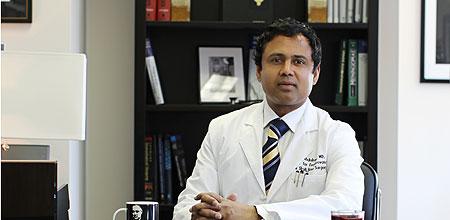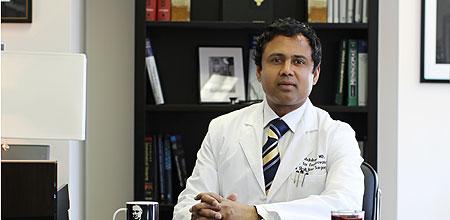
Credit: Saint Louis University
ST. LOUIS — In a first time study published in the August edition of the Journal of Neurosurgery, Saint Louis University surgeons and researchers report that the use of conscious sedation – also called "awake brain surgery" – allowed them to make adjustments mid-surgery to lower risks during aneurysm surgery.
The research was led by Saleem Abdulrauf, M.D., chair of neurosurgery at Saint Louis University and a SLUCare surgeon at SSM Health Saint Louis University Hospital. Abdulrauf is encouraged by the results of this study, which he hopes can reduce the risks associated with this type of brain surgery.
"Awake surgery for brain aneurysms may open a new frontier in neurosurgery that could lead to improved outcomes and decreased risk," says Abdulrauf. "This initial study is encouraging."
Surgeons use a technique called "clipping" to limit the damage of brain aneurysms, weak areas in blood vessel walls that can bulge or rupture. In this procedure, patients typically are given general anesthesia, the skull is opened by surgeons, and the artery is clipped below the aneurysm to prevent it from bursting.
Ischemia – inadequate blood supply to a part of the body – is a significant risk during this procedure that can cause neurological damage.
Abdulrauf and his team wanted to know if adding "awake" neurological testing to the procedure could help limit this risk. Awake surgery, through conscious sedation, has been used in neurosurgery in order for patients to maintain consciousness and communicate with doctors, giving surgeons "real time" information to see how their patients' brains are functioning during a surgery.
In the current study, 30 patients with aneurysms that had not burst were given awake neurological testing during their procedure. Three patients developed symptoms of neurological deterioration during the course of surgery.
Because the use of conscious sedation allowed the surgery team to communicate with these patients and note the nature of the neurological symptoms, the surgeons were able to make adjustments during surgery and eliminate the neurological symptoms that were being cause by lack of blood flow.
The researchers concluded that these patients benefited from the awake neurological testing by decreasing their risk of ischemic injury. Though more study is needed, the team is pleased that the study shows an avenue to explore as they aim to reduce risks associated with this type of brain surgery.
###
Other authors on the Saint Louis University study include Peter Vuong, M.D., Ritesh Patel, M.D., Raghu Sampath, M.D., Ahmed M. Ashour, M.D., Lauren M. Germany, B.S., Jonathon Lebovitz, M.D., Colt Brunson, D.O., Yuvraj Nijjar, M.D., J. Kyle Dryden, D.O., Maheen Q. Khan, M.D., Mihaela G. Stefan, M.D., Evan Wiley, M.D., Ryan T. Cleary, B.S., M.A., Connor Reis, B.S., Jodi Walsh, R.N., B.S.N., and Paula Buchanan, Ph.D., MPH.
Saint Louis University School of Medicine
Established in 1836, Saint Louis University School of Medicine has the distinction of awarding the first medical degree west of the Mississippi River. The school educates physicians and biomedical scientists, conducts medical research, and provides health care on a local, national and international level. Research at the school seeks new cures and treatments in five key areas: cancer, liver disease, heart/lung disease, aging and brain disease, and infectious diseases.
About SSM Health Saint Louis University Hospital
SSM Health is a Catholic, not-for-profit health system serving the comprehensive health needs of communities across the Midwest through one of the largest integrated delivery systems in the nation.
SSM Health Saint Louis University Hospital is a 356-bed quaternary and tertiary hospital specializing in organ transplants and home of the Mid-America Stroke Network. A teaching hospital, SSM Health Saint Louis University Hospital is home to SLUCare physicians and students of Saint Louis University Medical School. An ACS Level I trauma center for both Missouri and Illinois, Saint Louis University Hospital is accredited by the Joint Commission and designated as a Primary Stroke Center.
Media Contact
Carrie Bebermeyer
[email protected]
314-977-8015
@SLU_Official
http://www.slu.edu
Original Source
https://www.slu.edu/news/2017/august/awake-aneurysm-surgery.php





